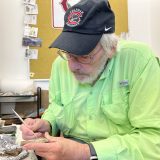Science Blender | Interdisciplinary Breakthrough at Stonehenge Student Essay from the HON 389 Science Blender Course
November 13, 2015
Throughout the year, we will be publishing essays from Professor Andrew Lyon‘s Honors 389 course “The Science Blender” . For the second paper this term, students were asked to investigate an “interdisciplinary breakthrough”. Below is one student’s essay on the topic.
For four years, the Stonehenge Hidden Landscapes Project has been underway, surveying the area, over four square miles, surrounding Stonehenge. Stonehenge is a “prehistoric stone circle monument, cemetery, and archaeological site located on Salisbury Plain, about 8 miles north of Salisbury, Wiltshire, England,” according to Encyclopedia Britannica,, and it was built between 3000 and 1520 BCE. The significance of Stonehenge is unknown, but there are many hypotheses surrounding its meaning— a temple, an instrument to predict solar and lunar eclipses, a monument for the dead or a place of healing, among other theories.
The Stonehenge Hidden Landscapes Project is a collaboration among the University of Birmingham, the Ludwig Boltzmann Institute for Archaeological Prospection and Virtual Archaeology, Vienna and its international partners, the University of Bradford, the University of St. Andrews and the ‘ORBit’ Research Group of the Department of Soil Management at the University of Ghent, Belgium (University of Birmingham). Vincent Gaffney is the project initiator, national project leader and an archaeologist and expert on the Stonehenge landscape. The team, however, is comprised of many people from many different disciplines:
archaeologists, photographers, an expert in system design and hardware, a remote sensing and airborne laser scanning expert, computer science engineers, experienced archaeological prospectors, a geometer, remote sensing experts, historians, an interactive animation and 3D visualization expert, an administration and accounting specialist, physicists, a 3D laser scanning expert, a software engineer, a bio-engineer, a soil and earth scientist, a proximal soil sensing expert, a geoarchaeologist and geophysicists.
This project would not be a success without each of the specialists.
The team used ground-penetrating radar, high resolution magnetometers and other remote-sensing equipment to map the area surrounding Stonehenge down to a depth of about ten feet. Smithsonian reported that they found buried evidence of over fifteen late Neolithic monuments including henges, barrows, segmented ditches, and pits. “Nobody had any idea this was here,” says Gaffney, the project initiator. “Instead of a monument in isolation, we find that Stonehenge was part of a rich
monumental landscape,” according to National Geographic.
The groundbreaking discoveries were made possible only by the latest technology. Roff Smith writes, “High-tech remote sensing and underground mapping is changing not only what is known about Stonehenge, but also the way archaeology is done.” This discovery and the new technology are the product of successful collaboration. This is a case of people from many different disciplines working together to accomplish something no one person or discipline could have done on its own.
About Honors 389: The Science Blender
Throughout Professor Lyon’s Science Blender course, students identify knowledge gaps that prevent simple solutions to grand challenges, and then they develop strategies to address those gaps. In this process, students also become more conversant in the languages of different disciplines and how team-based problem solving benefits scientific pursuits.


